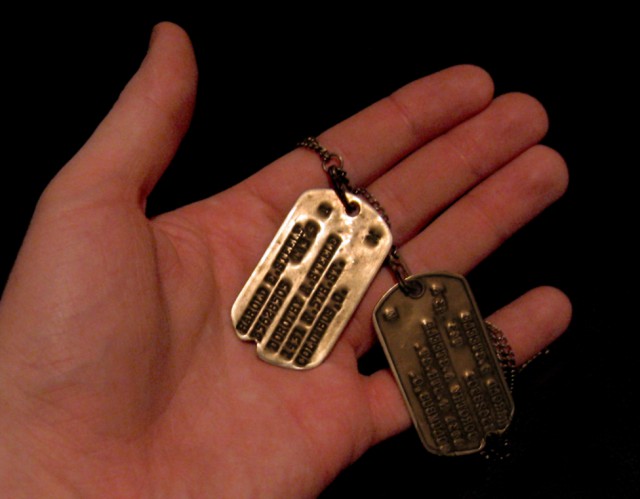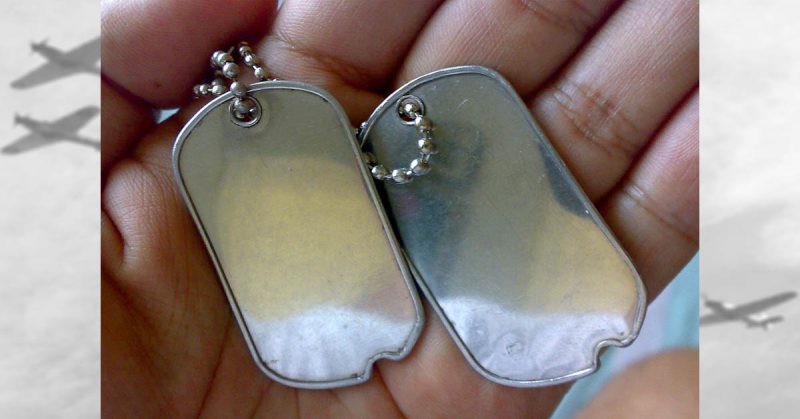They began with little more than an administrative importance but immediately became the dearest of keepsakes. The trifling piece of identification that would eventually morph into today’s “dog tags”, the original identification bracelet, was born during the American Civil War in a form of paper notes.
Over fifty million soldiers died, and millions more were wounded in WWII. Each man had to be identified, even if he was past speaking on his own behalf. A human life is more than a statistic, though; every life starts with a family, either by blood or by choice. When a soldier is killed in action, the ID bracelet is the bittersweet vestige of his life. When a soldier returns home, the ID bracelet is a trophy.

There were older methods of identifying soldiers. Spartans wrote their names on sticks and tied them to their wrists. Small round discs were made into crude necklaces during World War I, but they were not able to withstand the harsh conditions and were often lost.
The original military bracelets, like their older counterparts, displayed a soldier’s name, rank, and serial number. It might also signify the branch of service. Originally, they were made from a wire with a square medallion engraved with the information, but they were greatly improved with the link chain, and their appearance has changed little since this development.
Most people remember the ubiquitous “I.D. bracelets” from the late 1960s when they were worn by teenagers and traded for love. In the early 1970’s, bracelets with soldiers’ names on a single band, known as “POW bracelets” became even more popular.
As the name denotes, the names were of soldiers missing in action or known prisoners of war. Today, modern ID bracelets are mostly used to alert medical professionals of a person’s health status or of a handicap that is not outwardly visible. These are especially helpful to paramedics and EMTs.

Examples of soldiers’ veneration for these modest symbols of their service are not hard to find. Daniel “Dushan” Oresconin was born in 1916 and fought with the Army Air Corps in the South Pacific during World War II.
One might say he served his whole life, as he was a police officer for 36 years after his return home. He retired in 1976 with the rank of Captain. His ID bracelet was given to him by his mother, Rose, who gave one to both of her sons before each shipped out to war—a common practice at the time.
Any veteran or police officer would know that the two most important things in Dan’s life (other than his family) were his WWII ID bracelet and his police badge. According to his son Mark, the senior Oresconin lost the bracelet in the 60s. He’d worn it since the day he put it on his left wrist. Although Mark was just a child at the time, he remembers his father’s distress.
Mark said his father didn’t keep anything else from his military days. Until now, its only existence was in countless pictures of Dan wearing the bracelet. A newspaper photograph of Dan adorned in his uniform sporting the bracelet is a family favorite.
In the spring of 2018, Chris Zuccaro, an owner of Stevie’s Dari Mart in Aliquippa, Pennsylvania, found Dan’s ID bracelet with a metal detector in the backyard of Mark’s home. The home belonged to his dad until his death in December 1991.
Mark’s wife Julie recalls “[Chris and Mark] were both in the backyard screaming.” Zuccaro said he wasn’t looking for anything in particular when he happened upon the bracelet. Zuccaro seems to have a knack for finding things that are sentimentally important to the Oresconins – he also found Julie’s mother’s wedding band several years ago in her backyard.

There are many other stories like this. In 2017, Matthieu Delamontte found an ID bracelet that had been lost in a field near the beaches of Normandy over 70 years ago. It belonged to Army Sgt John Hill, who landed in France on June 7, 1944, the second day of the Allied invasion. He found Hill, now 93 and living in Syracuse, NY.
They were able to speak on Skype, surely a tearful meeting. In the early 1990s, Annandale, VA, resident Ellen Littlefield found an engraved bracelet from the US Marine Corps in her rose garden. Its owner, Major Loren Dale Everton, was a decorated fighting ace. Major Everton’s surviving brother requested that Ms. Littlefield donate the bracelet to the Stafford County Museum and Cultural Center, and they happily obliged.
